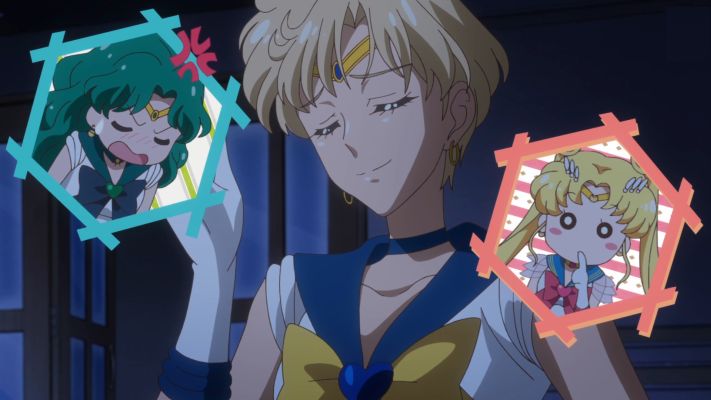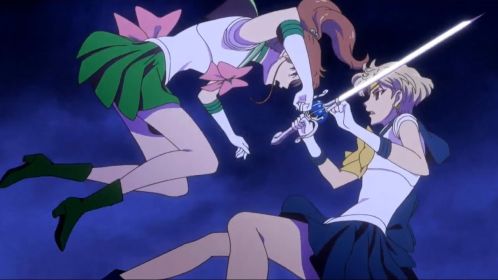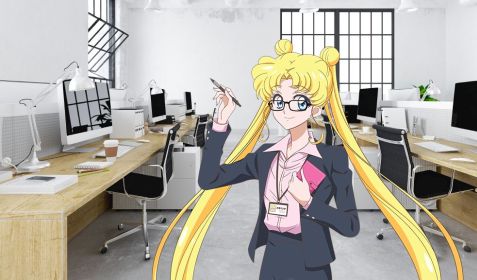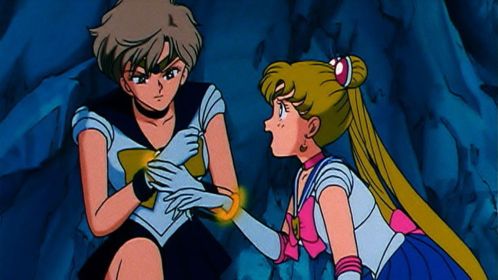As someone who’s fascinated by the nitty-gritty of how things work, the distinction between the Inner and Outer Senshi is a subject that I find incredibly interesting.
Though we’re given a (very) brief explanation within the series that the Inner team handles threats from within the Solar System and the Outers handle those from beyond, any other distinctions between the two groups are fairly vague and left up to fan conjecture.
Today we’ll be taking a look at how Iriya Azuma, producer of Sailor Moon S, approached these two teams and what he felt the distinction was between them. I hope you stick around, because this is actually pretty interesting!
To be totally frank, the breakdowns of the teams in the Sailor Moon series have always come off as a bit odd to me.
First off, we have the fact that Sailor Jupiter is a member of the Inner team, while the planet is an “outer” planet. I suppose I can overlook this discrepancy, though, since there’s no way that Ms. Takeuchi could have known that she would wind up representing every planet when the series first started.
Second, there’s the question on where Sailor ChibiMoon fits into all this craziness. The anime (and at least initially in the manga) seems to treat her as a sort of “junior” member of the Inners, which I guess is fair enough. But then she later gets her own team with the absolutely-have-nothing-to-do-with-the-Moon-or-the-future Asteroid Senshi of Sailors Ceres, Vesta, Juno, and Pallas.
Third, Saturn. I mean, that should be enough right there. Is she a member of the Outer senshi, or some rogue member totally on her own? In the Infinity Arc (Sailor Moon S) I’d say the latter, but from the Dream Arc (Sailor Moon SuperS) and on, it seems like the former. But then she also seems to be paired up with Sailor ChibiMoon in the manga, so is she an honorary member of the ChibiMoon/Asteroid/Saturn brigade? Who knows.
Finally, we’ve got the “original” Outer team of Sailors Uranus, Neptune, and Pluto. Is it pure coincidence, or by design that this team is so much more mature than the Inner team? And why should there be any difference in how they act compared to the other team?
Thankfully for us, our good friend and Sailor Moon S producer Iriya Azuma1 gave his thoughts on this exact subject in the Japanese anime magazine Animage.2
So what did he have to say about the two teams? Glad you asked!
The blurb was titled: 「ムーンはOL?」 or “Sailor Moon is an Office Lady?”
Apologies in advance for those of you who already know, but I feel like we need to take a quick timeout here and cover really quick just what in the heck an “office lady” (abbreviated “OL”) actually is:3
An office lady, often abbreviated OL, is a female office worker in Japan who performs generally pink collar tasks such as serving tea and secretarial or clerical work.
Basically, think a very generic, generally administrative role within a company. We won’t get into the specifics here, but let’s just say that you’re not really looking into a strong career path or growth in your role. You wouldn’t call a female boss an “office lady.”
Rather than spend a bunch of time going on about what he could possibly mean by that title, let’s just let the man speak for himself:
今回のシリーズに新たに登場した謎の戦士のウラヌス&ネプチューン。彼女たちはムーンたち5人より力&技&貫禄とも、はるかに格が上。
Uranus and Neptune, the two new, mysterious soldiers appearing in this series, are clearly at a whole different level in terms of strength, ability, and commanding presence compared to Moon and her team.
He goes on to explain:
この2人対5人の関係は、いってみれば会社のキャリアウーマン(古いいい方か)と新人OL(これも古い・・・)といったところでしょうか。偏見を持ちつづける男共を尻目に、華々しく活躍しつづける先輩OL。そんな先輩に憧れ、まだまだ甘いと叱られつつも、いつかは私も!と思っている新人OL。
同じプロジェクトを担当することになって、尊敬から反発へ、そして和解から連帯感へ・・・といった、ふたりの様々なドラマが生まれることになるでしょう・・・・。
ま、そんな雰囲気もチラ、と見せることができれば、と考えています。
To try to explain the dynamics between Sailors Uranus and Neptune and the other five Sailor Soldiers, well, I guess I’d say it’s like a career woman (that’s probably an outdated phrase) and a new office lady (that too) at a company.
While all the men in the office continue to hold onto their biases and look askance at her, this office lady who’s been in the company for awhile continues working right along with grace. And then there is this newbie office lady, thinking it’ll soon be her chance to shine, all the while getting scolded by the older woman for still being too naive. And yet, she admire this younger girl.
One day, they get assigned to the same project. What starts out as mutual respect turns into rivalry, followed by reconciliation, and then a sense of camaraderie. I’m sure throughout that process, all sorts of situations unfold between these two.
Well, at least that’s the kind of situation I’d like to give viewers a glimpse into.
This isn’t the first time that we’ve compared the world of Sailor Moon with the dynamics of Japanese corporate life, and I imagine it won’t be the last. But I have to say, as weird as this sounds, I feel like this description really does give an interesting insight into the relationship between the Inner Senshi and Sailor Uranus and Sailor Neptune, at least in the anime.
What do you think of this explanation offered up by the series director? A bit too much on the interpretive side, or maybe he wasn’t successful in getting the image across?
For me, personally, I don’t think I would have come to the assumption he outlined here if no one were to mention it to me. However, I can really get a sense of that underlying story element when I look back on the interactions between the teams across Sailor Moon S.
Of course, I love hearing other people’s views on things like this — especially from those who may not necessarily live and work in Japanese corporations. After nearly a decade living in Japan, I kind of lose touch with what’s “normal” in the West, so the fresh perspective is great to have!
References:
- See Iriya Azuma (Wikipedia) ↩
- See p. 97 of the June 1994 issue of Animage; see Animage (Wikipedia) ↩
- See Office Lady (Wikipedia) ↩





This sort of makes sense to me. I think in the West we have a similar dynamic and I’ve certainly observed it. You have people who have been working for the company for awhile and they know the office politics and how things get done and while they are aware of the problems of the company, they’ve been there so long that they’ve learned to work around them, instead of try to solve them. And then the newcomer comes onto the scene, very naive, but also very excited and gung-ho about helping out, and they start to point out all of the problems that the more senior people are aware of but have stopped talking about/solving and this tends to create friction. It’s annoying when the newbie acts like they just discovered something that everyone already knows about, and then worse, that they act like they can solve it. But at least the new person cares about the company. And sometimes it takes an outsider to get the senior people out of a rut of accepting problems instead of changing things. So I could see Usagi being like that– she rejected the whole paradigm of “Saturn has to die to save the world” or “We can’t risk it” and that struck the Outers as extremely naive. And it was, but also, there were other things at play that they couldn’t see but she could.
Of topic but I just had to write this: In episode 3 (episode 2 in US I think) in the 90s japanese animation, there is a weird sequence in the end when Tuxedo Mask is laughing. He’s saying goodbye and flying away and he’s laughing like a maniac, it’s a laugh that belongs to a villain! I always burst out laughing at that scene. I’m convinced something went wrong there..
I re-watched that recently and yeah I was always perplexed as to why he is laughing like that. Like what was the deal with having laughing like a maniac or mad scientist? It always struck me as really odd
Maybe it was an early installment attempt to give Tuxedo Mask some moral ambiguity or ‘bad boy’ image? Get the viewers thinking “who is this mysterious masked man in the fancy suit who keeps swooping in from out of the shadows to save the heroine? Is he a good guy? Is he secretly evil with a master plan of his own?”
If I remember rightly, Takeuchi did something like that with the character of Phantom Ace in the prototypical ‘Sailor V’ manga. Phantom Ace is a dashing masked man who assists Sailor V, but turns out to be the arc villain, Danburite, in disguise, pursuing Sailor V romantically while at the same time masterminding all the evil plots she’s fighting.
Obviously that question gets answered in the long run, but this is only three episodes in. By now we’ve seen Tuxedo Mask do his thing three times, but we don’t know a lot about why he does his thing.
So having Tuxedo Mask be a little bit sinister in some of his early appearances makes sense. It gives the audience the idea that maybe, just maybe, he’s not just this uncomplicated protector figure who pops out of nowhere, throws a rose, and pops back into nowhere.
That’s an interesting comparison. I feel that the anime didn’t really take that analogy to any conclusion, though – or, maybe, it did in the third season, but kind of reset the development in Stars.
While the Outers are definitely more experienced than Usagi and her guardians, they’re also… er, assigned to the wrong department at the time. They were not supposed to *be* on Earth, and by the time they show up it has become Usagi’s “workplace”. This is why I think their interactions in the manga (where they clearly respect Usagi from the start, but are still bound by their own mission since *they* messed up by letting the enemy arrive on Earth) make more sense than in the anime (where they usually seem to genuinely consider Usagi’s team an obstacle).
Which probably makes it less about Usagi being a newbie, and more about the Outers not being used to working on small-scale projects?
While a corporate office situation isn’t what would have come to mind for me, I think I understood his point perfectly and it makes a lot of sense. Haruka and Michiru are the pros and they just don’t trust the newbies to handle these really important tasks. But of course the new employees are also well-trained and have their own ideas (often better ones) about how things should be done, so there’s conflict.
You could probably make similar comparisons to sports teams, the military, or a lot of other situations where experts and young newcomers might be in conflict…
Definitely true! I think that the whole “corporate life” just so happens to be so deeply ingrained in Japanese society that it makes for a convenient example, though this same sort of phenomena could appear practically anywhere.
Regarding the “the absolutely-have-nothing-to-do-with-the-Moon-or-the-future Asteroid Senshi of Sailors Ceres, Vesta, Juno, and Pallas”….
It’s actually sort of perfect that it plays out this way for them in the series. After all…. what can be said about asteroids, if not that they’re just passing through?
In most case, that’d probably be true, but in the case of the Asteroid Belt Senshi, all of them have an incredibly stable orbit. In fact, last I checked, Ceres and Pluto are basically considered to be about one-in-the-same (in terms of being either a planetoid or asteroid).
But that’s neither here nor there! I still just find the whole concept to be a bit weird.
I think the comparison makes more sense if you consider it purely from Usagi’s starstruck point of view (like how the manga seemed to) but the anime seemed to want to spin it as literal fact, because to me it doesn’t really hold up under scrutiny; the whole maturity angle feels very surface level.
Where I think this analogy falls apart, at least for the anime, is the Outers being on some kind of superb level above the others is something we’re *told* much more than *shown*, and it’s not even something that lasts for very long. Yes, the Outers have an almost absurdly strong showing at the start — though the Inners suddenly get worse at everything they do was a red flag for me, as it felt like the writers were shilling to give some new unproven characters some quick credibility).
Yet about mid-way till nearly the end of the series, aren’t the Outers are generally LESS successful than the other team at the things they do? Most of the later scenarios I remember are when their solo plans simply doesn’t work out (and sometimes have to be actively bailed out by the Inners), their contrariness on an approach ends up being totally off base (e.g., handling the Starlights), or even manage to be active liabilities to plans (the SuperS teamup episodes)
I guess some of that is due to their role as secondary characters vs the primary characters needing to ultimately solve problems, because that’s how scripts work, but I always found the implicit hype behind the Outers to be lacking. I guess a better comparison would be two kinds of first-response teams insisting the other should go first.
As an addition: Also from the audience point of view the Outers are the ‘new’ team, not the Inners. You can’t really have the viewers be following a team for two years, with no foreshadowing at all of the other, then claim the second one’s exploits (all which occurred off-screen in a nebulous timespan) are suddenly ‘the established team’.
One has to remember when discussing the “why is Jupiter an inner planet” is that the term itself is pure Fanon. Unlike the outers, their group name is stated only in the manga and only once: Four Soldiers of the Guardian Gods, or Guardian Senshi, refering to their role as the Princess’ bodyguards. The group officially does not include either Moon as they did not exist in the Silver Millennium.
As noted in my reply to your other comment, I absolutely agree that the term “inner senshi” is a fan term.
However, “Outer Senshi” (a shortened version of “Soldiers of the Outer Solar System”) is not a fan-created term. The basis if the question is less about why Sailor Jupiter is a member of the so-called “inners” — which, as you mentioned, is not a canon term — and more a question of why she’s not a member of the “outers,” which is canonical.
In regards to the “inner versus outer” division, here’s a list of orbital radius in ‘astronomical units’ for various celestial bodies in our solar system, including the nine* planets.
0.4 Mercury
0.7 Venus
1.0 Earth (and the Moon)
1.5 Mars
2.8 Ceres (asteroids are mostly from 2.2 to 3.2 AU out)
5.2 Jupiter
9.5 Saturn
19.2 Uranus
30.1 Neptune
39.5 Pluto
Applying a bit of symbolism to this, at most times in its orbit, Jupiter is closer to any of the inner planets than it is to Saturn. Even at closest approach, it’s a close run thing which is nearer.
And for as far back as we can calculate planetary orbits, Jupiter has never, ever, not even once, not even for a moment been closer to Uranus, Neptune, or Pluto than it is to Mercury, Venus, Mars, or the Earth’s moon.
Nor will it ever be, for all the aeons of the foreseeable future.
____________________
*(So sorry. You cannot unplanet a planet. Especially not one with a heart on its tummy. Pluto remains a planet, so there. 😛 )
for me personally, i just find it unfair. Jupiter was unfairly done, and was done underrated.